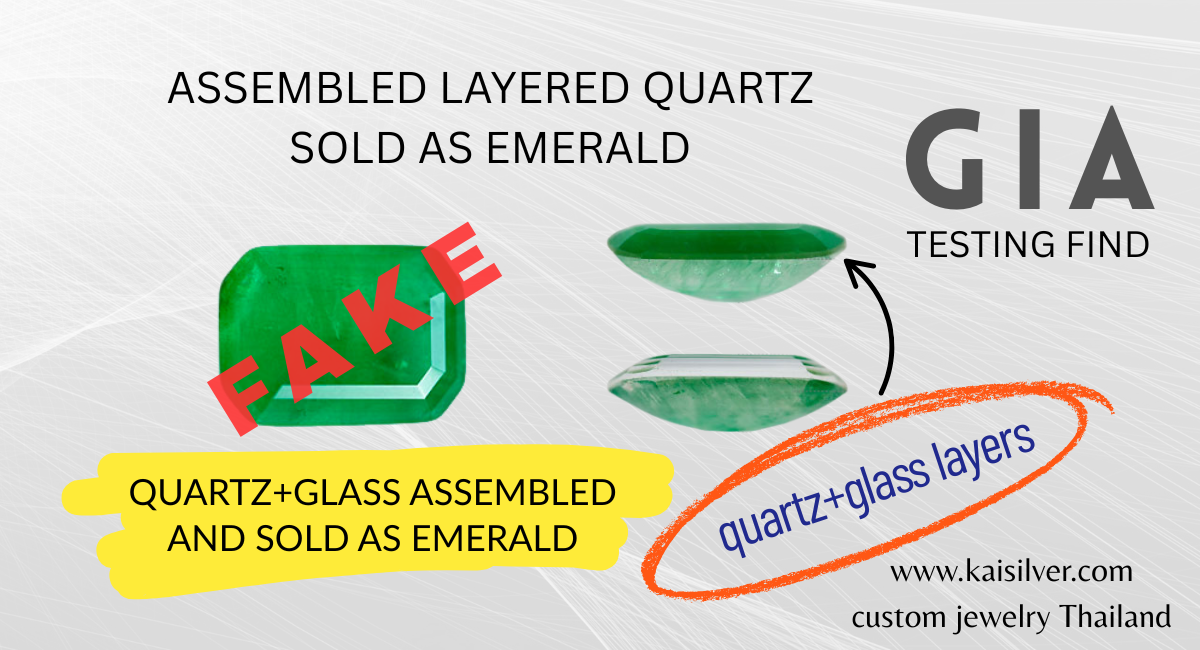QUARTZ GLASS 'EMERALD'
The information in this report remains relevant even today, the GIA case about a fake emerald happens to be one instance where, the gemstone was submitted for testing. Dozens of such cases related to emerald and other gems, would go without being inspected. Many casual jewelry and gem buyers without professional knowledge, are unaware about fakes – certification and possible fakes, might never be on their mind.

ASSEMBLED QUARTZ – FAKE EMERALD
The story of the fake emerald began when, the buyer of an expensive ‘emerald’ gemstone, requested for a certification from GIA. The gem was found to be an assembled quartz (triplet/assemblage), there was no element of emerald in the quartz assembly, not even a thin slice of the precious green stone.
Visual Inspection
On visual inspection GIA experts observed, a vivid bluish-green, emerald-cut stone sold/presented as an emerald — vivid color, many apparent inclusions, and a vitreous luster that at first glance looked emerald-like. Most gem testing laboratories, go beyond mere visual inspection when it comes to testing and certifying gemstones. GIA is obviously one of the top notch destinations for diamond and gemstone testing.
Further Testing
With visual inspection raising no doubt about the gem being an emerald, it took further tests and GIA expertise to identify the stone as an assembled piece of quartz. Needless to say, that the quartz gemstone, would be worth almost nothing. Selling that piece of quartz wrongly presenting it as an emerald, was done purely to gain commercial benefit.
Immersion microscopy and taking a profile view, was the next logical testing process. When viewed in immersion and from the side the layered construction often becomes obvious — the crown can appear colorless and clean at some angles while the pavilion is nearly colorless, revealing a layered structure. Air gaps, dye concentrations in the cement, or a visible interface can be seen.
At this point the observation of the emerald which in fact was little more than layered quartz and glass, raised serious doubts. The gem was constructed from more than one material (a colorless top or crown layer of quartz or glass, a colored cement/lamination layer that gives the green color, and a mostly colorless pavilion or body).
GIA experts were convinced that, this was a clear case where a cheap substitute was sold as an emerald. However research at GIA is an ongoing process, the team decided to further explore the structure of the assembled quartz stone that, was being labelled as emerald.
High powered microscopes were used to observe the layers and the portion, between the layers. It was important to identify the process or material that was deployed, to hold the layers of quartz and glass together. As observed through advanced microscopy, bubbles existed at the boundary between green cement and a quartz coating.
CONCLUSIONS
With the above testing done, not much was required to rightly identify the quartz, glass and binding material. Kaisilver experts are convinced that such misrepresentations, are much more common than believed. Besides outright frauds like the assembled piece of quartz being sold as emerald – disclosures of gem treatments, overstating price of various gems are common.
Over 95% of gemstones purchased, sold or used in jewelry remain uncertified. The cost of certification and lack of knowledge are the main reasons for this. Authenticity certificates are provided for all gemstones, sold and used in crafting jewelry by Kaisilver. The buyer might be requested to pay for certifications in cases where, certification from a specific gem testing lab is required.
SOURCE OF FRAUD
Taking the GIA fake emerald case as an example, it needs to be accepted that identifying the source of the fraud might be challenging. While Kaisilver procures gemstones directly from the miners or first level cutting operations, most dealers and consumers procure gems from a long supply chain.
Gems can go through dozens of brokers, agents, retailers and jewelers before reaching the consumer. The fake emerald was obviously sold at a high price, this is reason why the buyer was willing to pay the high certification fees that, GIA normal charges. It is quite possible that the fact that the gem was a fake, might have not be known to many or even most hands that formed the supply chain.
RECOMMENDATION
The best way to reduce or even eliminate chances of being cheated would be to, rely on reliable sources. While it would be best to always insist on a certification, lower priced gems might be unable to handle formal certification fees.
Kaisilver does not claim to be the only reliable gem and jewelry provider! Our production processes involve meticulously handcrafting all jewelry, in gold or silver with no limitation on design or gemstones. This explains why we are unable to accept a large number of orders. Unfortunately this is also the reason why, the Kaisilver team politely refuses to accept a few orders – this to avoid overloading our production floor.
